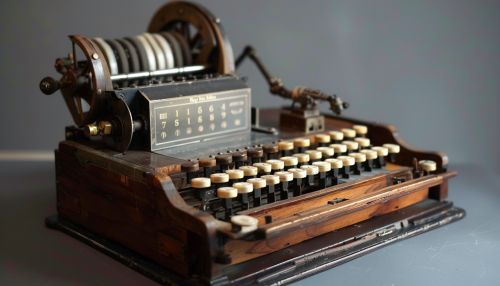Royal Earl House
Early Life and Education
Royal Earl House was born on September 9, 1814, in Rockingham, Vermont, United States. He was the son of a farmer and grew up in a rural environment. His early education was limited to the local schools, but he exhibited a keen interest in mechanics and engineering from a young age. House's natural aptitude for understanding mechanical systems led him to pursue self-education in the fields of engineering and invention.
Career and Inventions
Early Inventions
House's first significant invention was a mechanical printing press, which he developed in the 1830s. This invention was a precursor to his later work in telegraphy. The mechanical printing press allowed for more efficient printing processes and demonstrated House's ability to innovate in the field of mechanical engineering.
The Printing Telegraph
Royal Earl House is best known for his development of the printing telegraph, a revolutionary advancement in telegraphy. In the early 1840s, House began working on a device that could transmit messages over long distances and print them out at the receiving end. This invention was a significant improvement over the existing telegraph systems, which required operators to manually decode and transcribe messages.
The printing telegraph used a combination of mechanical and electrical components to achieve its functionality. It employed a keyboard for input, a mechanism for encoding the input into electrical signals, and a printing mechanism for output. The device could print messages directly onto paper, making it easier for operators to read and record the transmitted information.


House's printing telegraph was first demonstrated in 1846 and quickly gained attention for its efficiency and reliability. It was capable of transmitting messages at a much faster rate than existing systems, and the printed output reduced the likelihood of errors in message transcription.
Impact on Telegraphy
The introduction of House's printing telegraph had a profound impact on the field of telegraphy. It paved the way for more advanced telegraph systems and contributed to the rapid expansion of telegraph networks in the mid-19th century. The ability to transmit and print messages quickly and accurately was a significant advantage for businesses, governments, and individuals who relied on telegraph communication.
House's invention also influenced the development of subsequent telegraph technologies, including the Morse code telegraph and the teletypewriter. These advancements built upon the principles established by House's printing telegraph and further enhanced the efficiency and reliability of long-distance communication.
Later Life and Legacy
After the success of his printing telegraph, Royal Earl House continued to work on various engineering projects and inventions. He remained active in the field of telegraphy and contributed to the development of other communication technologies. House's work earned him recognition and respect within the scientific and engineering communities.
House passed away on February 25, 1895, in Bridgeport, Connecticut. His contributions to telegraphy and mechanical engineering left a lasting legacy, and he is remembered as a pioneer in the field of electrical communication.
